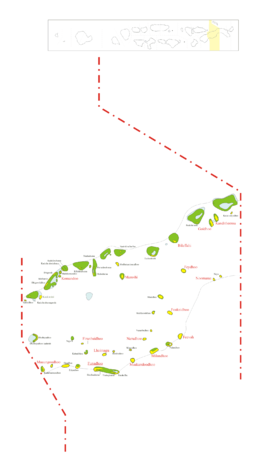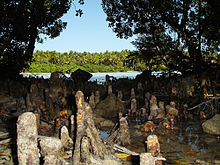- Shaviyani Atoll
-
Atoll Summary Administrative name Shaviyani Atoll Atoll name Miladhunmadulu Uthuruburi Location 6°30' N and 5°58' N Letter C Abbreviation Sh (ށ) Capital Funadhoo Population 14502 No. of Islands 51 Inhabited Islands 16 Atoll Chief Mohamed Mahir [1] Inhabited Islands Bileffahi Feevah Feydhoo Firunbaidhoo Foakaidhoo Funadhoo Goidhoo Kanditheemu Komandoo Lhaimagu Maakandoodhoo Maaungoodhoo Maroshi Milandhoo Narudhoo Noomaraa Uninhabited Islands Bis Huraa, Dhigu Rah, Dhiguvelldhoo, Dholhiyadhoo, Dholhiyadhoo Kudarah, Dhonveli-huraa, Ekasdhoo, Eriyadhoo, Farukolhu, Fushifarurah, Gaakoshinbi, Gallaidhoo, Hirubadhoo, Hurasfaruhuraa, Kabaalifaru, Keekimini, Killissafaruhuraa, Kudalhaimendhoo, Madidhoo, Madikurendhdhoo, Mathikomandoo, Medhurah, Medhukunburudhoo, Migoodhoo, Milandhoo, Naainfarufinolhu, Nalandhoo, Naruibudhoo, Neyo, Vagaru
Resort islands, Airports and Industrial islands are also considered uninhabitedShaviyani atoll is geographically located within the naturally occurring northern most atoll formation of Thiladhunmathi. A total of 52 islands, 15 inhabited and 36 uninhabited, form this atoll. Shaviyani Atoll also known as Miladhunmadulu Uthuruburi (Northern Miladhunmadulu Atoll) is an Administrative division of the Maldives. It corresponds to the northern section of Miladhunmadulu atoll located in the north of the Maldives.
The islands in this atoll are small with half of the islands having less than 20 hectares of land area. There are 9 islands that are smaller than one hectare. These islands comprise 18% of the islands. The smallness of the atoll indicates to the islands' vulnerability to environmental impacts.
Contents
Geography
This administrative atoll is 37 miles long, it is the third atoll from the northern edge of the country, and is assigned the Maldivian letter 'Shaviyani' and the Latin letter 'C' as the atoll code. It comprises 51 islands of which 16 are inhabited.
NOTE: Haa Alifu, Haa Dhaalu, Shaviyani, Noonu, Raa, Baa, Kaafu, etc. are code letters assigned to the present administrative divisions of the Maldives. They are not the proper names of the natural atolls that make up these divisions. Some atolls are divided into two administrative divisions while other divisions are made up of two or more natural atolls. The order followed by the code letters is from North to South, beginning with the first letters of the Thaana alphabet used in Dhivehi. These code letters are not accurate from the geographical and cultural point of view. However, they have become popular among tourists and foreigners in the Maldives who find them easier to pronounce than the true atoll names in Dhivehi, (save a few exceptions, like Ari Atoll).[1]Population
The population of the atoll crossed 14000 in 2003.
Economy
Fishing and agriculture form the mainstay of the atoll's economy. Fishing is engaged in throughout the year, with pole, line and reef fishing practised in various islands in the atoll. The atoll is also known for craftsmanship, such as mat and rope weaving.
Several inhabitants work in the tourism industry and other commercial trades in the Maldivian capital, Malé.
Administration
The atoll office is responsible for public services, development and economic affairs. The Shaviyani Atoll Office was established on 9 September 1958 by the state. Until 1st January 1968, the atoll office was located in Lhaimagu which was the capital of the atoll. The government declared that effective from 1st January 1968, the capital would be Farukolhu Funadhoo (Funadhoo) and hence, the atoll office was transferred to Funadhoo.
Health
Basic medical care was introduced for the first time in the atoll with the establishment of a health centre on 25 December 1970 in the island of Lhaimagu. This health centre was shifted to Farukolhu Funadhoo (now Funadhoo) in 1971 when the island was made the atoll capital. This health centre is now developed to Atoll Hospital which has a well equipped laboratory and operation theatre facilities and are manned by a gynechologist, anaesthesist and a general practitioner.
Majority of the population of the atoll have access to safe drinking water. 40% of the households have been provided with water storage tanks on a soft loan basis under the Shaviyani Atoll development project and Atoll Development Committee. Most households have safe sanitation facilities.
Education
Primary education is universal in all inhabited islands of Shaviyani Atoll. Every island has a school providing education at least up to primary level. These include 3 government schools, 1 private school and 12 community schools. A total of 8 schools which teach up to secondary level education are in the atoll. They are the Atoll Education Centre, Atoll School, Funadhoo School, Milandhoo School, Madharusathul Munawwara in Maroshi, Feevah School, Foakaidhoo School, Maaungoodhoo School and Lhaimagu School. Most of the secondary schools yet offer only commerce stream subjects. The schools which offer both the Science and Commerce streme subjects are the Shaviyani Atoll Education Centre in Komandoo and the 3 schools in Kanditheemu, Maakandoodhoo and Milandhoo. Most schools have computer labs funded jointly by parents, government and the Shaviyani Atoll Development Project.
References
- ^ Tim Godfrey, Atlas of the Maldives, Atoll Editions 2004
- Divehi Tārīkhah Au Alikameh. Divehi Bahāi Tārikhah Khidmaiykurā Qaumī Markazu. Reprint 1958 edn. Malé 1990.
- Divehiraajjege Jōgrafīge Vanavaru. Muhammadu Ibrahim Lutfee. G.Sōsanī.
- Xavier Romero-Frias, The Maldive Islanders, A Study of the Popular Culture of an Ancient Ocean Kingdom. Barcelona 1999.
Administrative Divisions of the Maldives Mathi-Uthuru (Upper North) 
Uthuru (North) Medhu-Uthuru (North Central) Medhu (Central) Mathi-Dhekunu (Upper South) Medhu-Dhekunu (South Central) Dhekunu (South) Gnaviyani · AdduCategories:- Maldives geography stubs
- Administrative atolls of the Maldives
Wikimedia Foundation. 2010.


